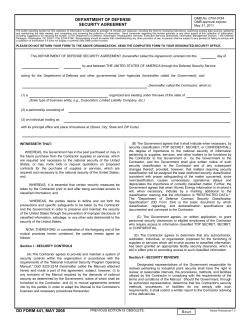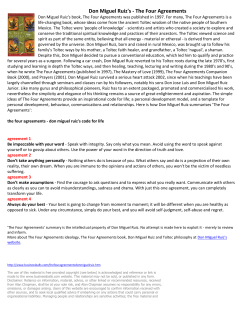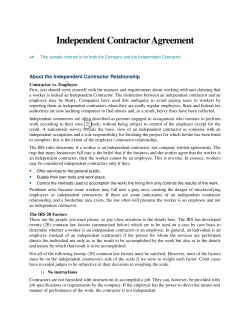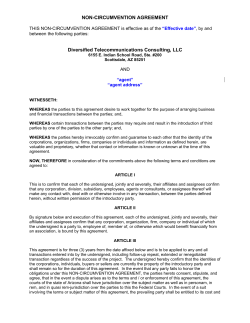
T A eaming greements:
Teaming Agreements: BY L au ren J. Caisse 30 Contract Management | April 2010 To Team or Not to Team? A practical guide to forming contractor team arrangements. Contract Management | April 2010 31 T he Federal Acquisition Regulation (FAR) defines contractor team arrangement as “an arrangement in which (1) two or more companies form a partnership or joint venture to act as a potential prime contractor; or (2) a potential prime contractor agrees with one or more other companies to have them act as its subcontractors under a specified government contract or acquisition program.”1 FAR policy states that teaming arrangements are recognized by the government provided “the arrangements are identified and company relationships are fully disclosed in an offer or, for arrangements entered into after submission of an offer, before the arrangement becomes effective.”2 Why have teaming arrangements? The FAR recognizes that teaming arrangements “may be desirable from both a government and industry standpoint in order to enable the companies involved to (1) complement each other’s unique capabilities; and (2) offer the government the best combination of performance, cost, and delivery for the system or product being acquired.”3 In many ways, a teaming agreement is like a marriage: it should not be entered into lightly because if expectations are not met, the dissolution of the team can be very bitter. “Teaming agreements are agreements entered into by two or more contractors to pursue a specific opportunity 32 Contract Management | April 2010 Teaming agreements: To Team or not to Team? for purposes of joining qualifications and experience and combining bonding and resource capacity.”4 During the proposal stage, teaming agreements are most often in the form of a prime contractor with a subcontractor as a committed team member and, if that prime contractor wins the proposal, the team member is committed to being awarded a subcontract and executing the subcontract work. Teaming agreements can be on an “exclusive” or “nonexclusive” basis. On a mutually exclusive teaming agreement, the prime contractor promises to not solicit other subcontractors for the same work and the subcontractor promises not to provide bids or proposals for its services to any other prime intending to bid on the same proposal. Conversely, in a nonexclusive teaming agreement, the nonexclusive party is not exclusive to the other party and may provide a quote or proposal to another prime bidding on the same proposal or ask for pricing from other subs that provide the same services. Teaming agreements can be a “one time shot” or on an ongoing basis, such as on an indefinite delivery/indefinite quantity (IDIQ) contract. Especially in the latter case, it is imperative to manage the expectations of both parties. For example, will all potential task orders be proposed on or only on some? If the prime contractor only intends to propose on a select few task orders (or vice versa), this needs to be made known to the potential team partner to manage the expectations. Before exploring the possibility of a teaming arrangement with another firm, it is a best practice for both firms to sign a confidentiality or nondisclosure agreement so as to protect any confidential information that may be divulged in assessing whether or not the two firms are a good fit. Issues to Consider There are many issues to take into consideration before entering into a teaming agreement, whether it is with a firm you have never worked with before, a firm you have worked with many times in a prime/ subcontractor or subcontractor/prime relationship, or even if you have teamed with the firm in the past. These issues include: Safety record, Past performance, Financial resources, Bonding capability, Strengths and weaknesses of both firms, and Cultural fits/core values. Safety Record It is imperative that you consider and evaluate the teaming partner’s health and safety record as it pertains to OSHA recordables, experience modification rate (EMR), health and Teaming agreements: To Team or not to Team? publicly owned, you can still ask for their financial statements. If they will not provide them, ask for their financial liquidity rations to be provided by their independent auditor and have your finance manager provide an analysis and/or opinion. Bonding Capability If your client is going to require performance and payment bonds on the project, a consideration must be whether you will require bonds of your potential team partner if you were to award them a subcontract. Given such, it is important to ask the potential team partner the following: safety plan, and other data that provides a complete picture of the partner’s commitment to safety. Doing so early on in the process ensures that there will be no surprises when it comes to awarding work. A firm that has set the bar high in terms of safety culture will not mesh easily with a firm where safety is an afterthought. Some firms have a hard and fast rule not to subcontract to firms with an EMR greater than 1.0. Past Performance A potential teaming partner’s past performance in the area of work to be performed, at the location to be performed, and for the client or end user being proposed to is very important. If a potential teaming partner says they have past experience at the location where you are proposing to do work, be sure to do some intelligence and speak with those who have first-hand knowledge of how that past experience was regarded. Were the client and/or the end user happy with the finished product or service? Is the potential team partner welcome back at that base or end user facility? Is the potential team partner a company that suppliers and lower-tier subcontractors want to do business with? Are they fair, respectful, and do they pay their bills on time? 34 Contract Management | April 2010 What is their total bonding capability? How much of that capacity do they currently have available? Do they have any potential or actual projects in the pipeline that would positively or negatively impact that bonding capacity? Who is their bonding company? What is their cost per thousand on their bonds? Financial Resources With regards to financial capability, it is always wise to pull a “Dun & Bradstreet” report and have your internal risk manager provide you with an analysis. Dun & Bradstreet (www.dnb.com) is a commercial organization that for a fee provides various information, services, and reports on businesses worldwide. Although a Dun & Bradstreet is a “look back” of past history, careful scrutiny can unveil any trends that may be occurring. For example, is the potential team partner heavily indebted, whereas the smallest cash flow “crunch” could compromise the potential team partner’s work? Are there any payment trends emerging from the Dun & Bradstreet report? Are there any outstanding liens or pending lawsuits showing on the report that give you cause for concern? If the potential team partner is a publiclyowned company, request copies of audited financial statements for the past two or three years and have your finance manager review them and advise of any concerns. If the potential team partner is not The key on bonding is whether or not the potential team partner has a good track record and if they have the capability to bond their work. After the collapse of the U.S. banking system in late 2008 and ensuing problems at AIG (the world’s largest bonding company), bonds are more difficult to Teaming agreements work best in those situations where the prime contractor is weak or lacking in a given area and the potential team partner has strength in that area. Teaming agreements: To Team or not to Team? obtain and retain. If a potential team partner is not able to bond their work solely because they do not have the capacity, it may be worth exploring the possibility of a more comprehensive payment retention scheme. If the potential team partner has a high bond rate (cost per thousand) in comparison to other companies that perform the same work, this should be a red flag and warrant further due diligence to ascertain why this is the case. overlaps which may cause a tug-of-war later on as to who performs the work that both companies are capable of doing. Weaknesses of both firms—and the teaming arrangement as a whole—should be reviewed and mitigated or eliminated if at all possible. The primary goal of the teaming agreement should be to ensure that there are no weaknesses or holes in the proposal being submitted to the government. Strengths and Weaknesses of Both Firms An area often overlooked in teaming arrangements is the cultural fit and core values of the two team partners. These can include: Cultural Fits/Core Values Teaming agreements work best in those situations where the prime contractor is weak or lacking in a given area and the potential team partner has strength in that area. The strength could be the potential team partner’s technical know-how, unique capabilities, successful past performance at that base, personnel resources, proximity to the project site, a certain piece of equipment, or positive past performance with that client. The strength and weaknesses of both firms, and what each firm has to offer to the team, should be looked at closely—and very early on in the process when considering a teaming arrangement—so that there are no large 36 Contract Management | April 2010 Work to be awarded to local and small businesses, Emphasis on maintaining client relationships and partnering with them, Focus on providing a safe work environment, Degree of risk that each partner is willing to take, Ethics compliance, Litigation history, and The simple question of “do/will we and our people get along with them?” Although this list appears intuitive, if the team partners do not share the same values and goals for the project, program, or client, it makes it difficult to manage the team arrangement. Again, it is another degree of managing expectations. Teaming Agreements for Work to be Performed Abroad If the teaming agreement contemplated is for work to be performed in other countries, especially high-risk countries, it is imperative “that you understand what policies and procedures and other internal controls” your potential teaming partner “has with respect to compliance with the Foreign Corrupt Practices Act and export controls.”5 If both team partners are U.S. firms, it is wise to decide which firm’s set of policies and internal controls apply or whether special compliance procedures should be implemented for the teaming entity. If one team partner is not a U.S. firm, it is extremely important to perform due Teaming agreements: To Team or not to Team? diligence to ensure that, at a minimum, the firm understands U.S. anticorruption laws, export controls, and overall compliance with the FAR. Part of the due diligence process should be drilling down to who actually owns the foreign company and performing due diligence on the actual owners to determine any ties to foreign officials. “[I]n certain regions of the world, smaller or non-peer group companies may conceivably represent compliance risks due to lack of transparent ownership (including potential ties to foreign officials) or potential ties to individuals or entities involved in activities such as terrorism or money laundering….”6 The best course of action is to engage your legal counsel to help perform due diligence on any firm(s) you are considering for a teaming agreement for work in other countries. trust, especially where the parties are not familiar with one another. However, prescreening and due diligence on the firm that you are looking to team with, coupled with a properly drafted teaming agreement, will go a long way to ensure that the teaming arrangement is a good match and both parties will be successful. To quote a phrase often used by the late President Ronald Reagan, “trust but verify.” CM About the Author Ideally, prescreening and due diligence of potential team partners are done well in advance of a solicitation coming out. Entering into a teaming agreement often entails To discuss this article with your peers online, go to www.ncmahq.org/cm0410/Caisse and click on “Join Discussion.” Endnotes 1. FAR 9.601. 2. FAR 9.603. 3. FAR 9.602. 4. See, generally, Humphries & Irwin, “Teaming Agreements/Edition III,” Briefing Papers No. 03-10 (September 2003). 5. Andrew D. Irwin, Negar Katirai, and David S. Lorello; “Due Diligence & Compliance Risk Management Abroad for Government Contractors”; Briefing Papers (May 2007). 6. Ibid. LAUREN J. CAISSE, CPCM, JD, is a contracts administrator and corporate counsel at Environmental Chemical Corporation in Marlborough, Massachusetts. She earned her JD at Suffolk University Law School and is licensed to practice law in both Massachusetts and Conclusion Send comments about this article to cm@ncmahq.org. Rhode Island. She also holds an MBA from Anna Maria College. She was the recipient of the Contract Management Institute’s Marty Kaufman Scholarship in 2001. She is also a member of NCMA’s Boston Chapter. Contract Management | April 2010 37
© Copyright 2025
















